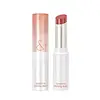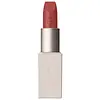What's inside
What's inside
 Key Ingredients
Key Ingredients

 Benefits
Benefits

 Concerns
Concerns

 Ingredients Side-by-side
Ingredients Side-by-side

Diisostearyl Malate
EmollientBis-Behenyl/Isostearyl/Phytosteryl Dimer Dilinoleyl Dimer Dilinoleate
EmollientPolyglyceryl-2 Triisostearate
EmulsifyingBis-Diglyceryl Polyacyladipate-2
EmollientParaffin
PerfumingTridecyl Trimellitate
EmollientPentaerythrityl Tetraisostearate
EmollientMicrocrystalline Wax
Emulsion StabilisingSorbitan Isostearate
EmulsifyingCI 77891
Cosmetic Colorant1,2-Hexanediol
Skin ConditioningDisteardimonium Hectorite
StabilisingSynthetic Wax
AbrasiveCI 19140
Cosmetic ColorantEthylene/Propylene Copolymer
AbrasiveCI 77491
Cosmetic ColorantPropylene Carbonate
SolventCI 15850
Cosmetic ColorantCI 77499
Cosmetic ColorantParfum
MaskingLimonene
PerfumingCI 42090
Cosmetic ColorantLinalool
PerfumingButyrospermum Parkii Butter
Skin ConditioningCamellia Japonica Seed Oil
EmollientCaprylic/Capric Triglyceride
MaskingArgania Spinosa Kernel Oil
EmollientSimmondsia Chinensis Seed Oil
EmollientPrunus Amygdalus Dulcis Oil
Skin ConditioningPrunus Armeniaca Kernel Oil
MaskingOenothera Biennis Oil
EmollientOlea Europaea Fruit
AbrasiveMangifera Indica Fruit Extract
Skin ConditioningRosa Canina Fruit Extract
AstringentDiisostearyl Malate, Bis-Behenyl/Isostearyl/Phytosteryl Dimer Dilinoleyl Dimer Dilinoleate, Polyglyceryl-2 Triisostearate, Bis-Diglyceryl Polyacyladipate-2, Paraffin, Tridecyl Trimellitate, Pentaerythrityl Tetraisostearate, Microcrystalline Wax, Sorbitan Isostearate, CI 77891, 1,2-Hexanediol, Disteardimonium Hectorite, Synthetic Wax, CI 19140, Ethylene/Propylene Copolymer, CI 77491, Propylene Carbonate, CI 15850, CI 77499, Parfum, Limonene, CI 42090, Linalool, Butyrospermum Parkii Butter, Camellia Japonica Seed Oil, Caprylic/Capric Triglyceride, Argania Spinosa Kernel Oil, Simmondsia Chinensis Seed Oil, Prunus Amygdalus Dulcis Oil, Prunus Armeniaca Kernel Oil, Oenothera Biennis Oil, Olea Europaea Fruit, Mangifera Indica Fruit Extract, Rosa Canina Fruit Extract
Pentaerythrityl Tetraisostearate
EmollientCaprylic/Capric Triglyceride
MaskingRicinus Communis Seed Oil
MaskingBis-Diglyceryl Polyacyladipate-2
EmollientSynthetic Wax
AbrasiveEuphorbia Cerifera Wax
Hydrogenated Vegetable Oil
EmollientEthylene/Propylene Copolymer
AbrasiveIsopropyl Palmitate
EmollientSilica
AbrasiveSwertia Chirata Extract
HumectantBrassica Alba Sprout Extract
Skin ConditioningSqualane
EmollientSodium Hyaluronate
HumectantC13-15 Alkane
SolventHelianthus Annuus Seed Oil
EmollientHydrogenated Castor Oil
EmollientRosmarinus Officinalis Leaf Extract
AntimicrobialLecithin
Emollient1,2-Hexanediol
Skin ConditioningCaprylyl Glycol
EmollientPhenethyl Alcohol
MaskingCymbopogon Martini Herb Oil
PerfumingCoriandrum Sativum Fruit Oil
MaskingEthyl Vanillin
MaskingPelargonium Graveolens Oil
MaskingWater
Skin ConditioningGeraniol
PerfumingLinalool
PerfumingCitronellol
PerfumingCI 77891
Cosmetic ColorantIron Oxides
CI 15850
Cosmetic ColorantCI 45410
Cosmetic ColorantCI 19140
Cosmetic ColorantCI 42090
Cosmetic ColorantPentaerythrityl Tetraisostearate, Caprylic/Capric Triglyceride, Ricinus Communis Seed Oil, Bis-Diglyceryl Polyacyladipate-2, Synthetic Wax, Euphorbia Cerifera Wax, Hydrogenated Vegetable Oil, Ethylene/Propylene Copolymer, Isopropyl Palmitate, Silica, Swertia Chirata Extract, Brassica Alba Sprout Extract, Squalane, Sodium Hyaluronate, C13-15 Alkane, Helianthus Annuus Seed Oil, Hydrogenated Castor Oil, Rosmarinus Officinalis Leaf Extract, Lecithin, 1,2-Hexanediol, Caprylyl Glycol, Phenethyl Alcohol, Cymbopogon Martini Herb Oil, Coriandrum Sativum Fruit Oil, Ethyl Vanillin, Pelargonium Graveolens Oil, Water, Geraniol, Linalool, Citronellol, CI 77891, Iron Oxides, CI 15850, CI 45410, CI 19140, CI 42090
 Reviews
Reviews

Ingredients Explained
These ingredients are found in both products.
Ingredients higher up in an ingredient list are typically present in a larger amount.
1,2-Hexanediol is a synthetic liquid and another multi-functional powerhouse.
It is a:
- Humectant, drawing moisture into the skin
- Emollient, helping to soften skin
- Solvent, dispersing and stabilizing formulas
- Preservative booster, enhancing the antimicrobial activity of other preservatives
This ingredient is lipid-based synthetic skin-conditioning agent derived from adipic acid and a mixture of fatty acids. It is often called a lanolin substitute.
As an emollient, it helps soften and hydrate the skin. Emollients create a barrier on the skin to trap moisture in.
Due to its fatty acid base, it may not be Malassezia folliculitis safe.
Learn more about Bis-Diglyceryl Polyacyladipate-2This ingredient is an emollient, solvent, and texture enhancer. It is considered a skin-softener by helping the skin prevent moisture loss.
It helps thicken a product's formula and makes it easier to spread by dissolving clumping compounds.
Caprylic Triglyceride is made by combining glycerin with coconut oil, forming a clear liquid.
While there is an assumption Caprylic Triglyceride can clog pores due to it being derived from coconut oil, there is no research supporting this.
Learn more about Caprylic/Capric TriglycerideCi 15850 is the pigment color red. It is an azo dye and created synthetically.
Azo dyes need to be thoroughly purified before use. This allows them to be more stable and longer-lasting.
This ingredient is common in foundations, lipsticks, and blushes. This color is described as brown/orangey red.
It has many secondary names such as Red 6 and Red 7. According to a manufacturer, Red 6 usually contains aluminum.
Learn more about CI 15850CI 19140 is also known as Tartrazine. Tartrazine is a synthetic dye used in cosmetics, foods, and medicine to add a yellow color.
Tartrazine is created from petroleum and is water-soluble.
Some people may experience allergies from this dye, especially asthmatics and those with an aspirin intolerance.
Learn more about CI 19140Ci 42090 is a synthetic dye created from petroleum. It is used to give a bright blue color to cosmetics, medicine, and food.
Ci 77891 is a white pigment from Titanium dioxide. It is naturally found in minerals such as rutile and ilmenite.
It's main function is to add a white color to cosmetics. It can also be mixed with other colors to create different shades.
Ci 77891 is commonly found in sunscreens due to its ability to block UV rays.
Learn more about CI 77891Ethylene/Propylene Copolymer is an exfoliant.
Linalool is a fragrance and helps add scent to products. It's derived from common plants such as cinnamon, mint, citrus, and lavender.
Like Limonene, this ingredient oxidizes when exposed to air. Oxidized linalool can cause allergies and skin sensitivity.
This ingredient has a scent that is floral, spicy tropical, and citrus-like.
Learn more about LinaloolPentaerythrityl Tetraisostearate is derived from isostearic acid. It is an emollient and emulsifier.
The highest concentration of this ingredient is found in lipsticks.
This ingredient is minimally water soluble and may not be Malassezia folliculitis, or fungal-acne safe.
Learn more about Pentaerythrityl TetraisostearateSynthetic Wax is created from fossil fuels such as natural gas. It is used to enhance texture, adjust pH, and as an occlusive.
It may also be used as an abrasive ingredient to exfoliate the skin.
Synthetic Wax may not be fungal acne safe.
Learn more about Synthetic Wax